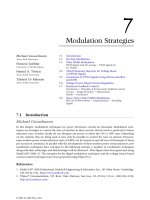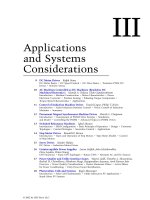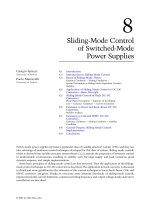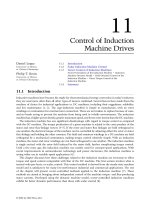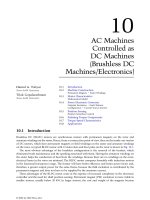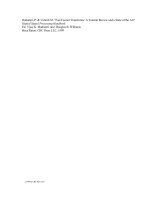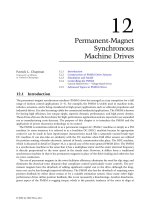Power Electronic Handbook P7
Bạn đang xem bản rút gọn của tài liệu. Xem và tải ngay bản đầy đủ của tài liệu tại đây (1.58 MB, 35 trang )
© 2002 by CRC Press LLC
7
Modulation Strategies
7.1 Introduction
7.2 Six-Step Modulation
7.3 Pulse Width Modulation
PWM Signals with DC Average • PWM Signals for
AC Output
7.4 Third Harmonic Injection for Voltage Boost
of SPWM Signals
7.5 Generation of PWM Signals Using Microcontrollers
and DSPs
7.6 Voltage Source–Based Current Regulation
7.7 Hysteresis Feedback Control
Introduction • Principles of the Hysteresis Feedback Control
Circuits • Design Procedure • Experimental
Results • Conclusions
7.8 Space-Vector Pulse Width Modulation
How the SVPWM Works • Implementation • Switching
Signals
7.1 Introduction
Michael Giesselmann
In this chapter, modulation techniques for power electronics circuits are discussed. Modulation tech-
niques are strategies to control the state of switches in these circuits. Switch mode is preferred to linear
operation since switches ideally do not dissipate any power in either the ON or OFF state. Depending
on the switches that are being used, it may only be possible to control the turn on instants. However,
most modern power semiconductors such as IGBTs can be turned on and off tens of thousands of times
per second on command. In parallel with the development of these modern power semiconductors, new
modulation techniques have emerged. In the following sections, a number of modulation techniques
along with their advantages and disadvantages will be discussed. Most figures have been generated using
MathCAD® 2000 [1]. The examples for the digital modulation techniques and the voltage source–based
current control techniques have been generated using PSpice®[2].
References
1. MathCAD® 2000 Professional, MathSoft Engineering & Education, Inc., 101 Main Street, Cambridge,
MA 02142-1521, .
2. PSpice® Documentation, 555 River Oaks Parkway, San Jose, CA 95134, U.S.A.; (408)-943-1234;
/>
Michael Giesselmann
Texas Tech University
Hossein Salehfar
University of North Dakota
Hamid A. Toliyat
Texas A&M University
Tahmid Ur Rahman
Texas A&M University
© 2002 by CRC Press LLC
7.2 Six-Step Modulation
Michael Giesselmann
Six-step modulation represents an early technique to control a three-phase inverter. Six-step modulation
uses a sequence of six switching patterns for the three phase legs of a full-bridge inverter to generate a
full cycle of three-phase voltages. A switch pair connected between the positive DC bus and the negative
DC bus represents a phase leg. The output terminal is the midpoint of the two switches. Only one switch
of a phase leg may be turned on at any given time to prevent a short circuit between the DC buses. One
state of the inverter leg represents the case when the upper switch is turned on whereas the opposite state
is represented by the lower switch being turned on. If each phase leg has these two states, the inverter has
2
3
=
8 possible switching states. Six of these states are active states, whereas the two states in which either
all of the upper or all of the lower switches are turned on are called zero states, because the line-to-line
output voltage is zero in these cases. The six discrete switching patterns for six-step modulation are shown
in Fig. 7.1a to f. For clarity, free-wheeling diodes have been omitted. After the switching pattern shown
in Fig. 7.1f, the cycle begins anew with the switching pattern shown in Fig. 7.1a. Note that in subsequent
patterns, only a single inverter leg changes states. The switching patterns shown in Fig. 7.1a to f represent
the following inverter states in the following order:
• Positive peak of Phase A
• Negative peak of Phase C
• Positive peak of Phase B
• Negative peak of Phase A
• Positive peak of Phase C
• Negative peak of Phase B
The aforementioned inverter states are equally spaced in a circle with 60
°
of phase shift between them.
This is illustrated in Fig. 7.2. The hexagon in Fig. 7.2 represents the trace of a voltage vector around a
circle for six-step modulation. This scheme could be extended to space vector modulation, if the voltage
vector would not make discrete 60
°
steps, but would alternate at high speed between two adjacent states.
The switching control would be such that the average time spend in the previous state is gradually
decreasing, whereas the average time spent in the next state is gradually increasing. Also by inserting zero
states, the magnitude of the output voltage could be controlled.
Figure 7.3 shows the phase to neutral waveform of one inverter leg for six-step operation if the neutral point
is considered the midpoint between the positive and negative bus. The resulting line-to-line output voltage
is shown in Fig. 7.4. This waveform is closer to a sinusoid than the phase to neutral voltage but it still has a
considerable amount of harmonics. Figure 7.5 shows the spectrum of the line-to-line voltage for six-step
operation normalized to the fundamental frequency. The lowest harmonic component is the 5th harmonic.
The advantages of six-step modulation are the simplicity of the procedure and the ability to use slow-
switching, high-power devices like GTOs. However, the harmonic content of the output voltage and the
inability to control the magnitude of the output voltage are serious drawbacks. Because of these drawbacks
and due to the recent advances in high-power IGBT technology, this modulation scheme is today seldom
considered for new designs.
7.3 Pulse Width Modulation
Michael Giesselmann
Pulse width modulation (PWM) is the method of choice to control modern power electronics circuits. The
basic idea is to control the duty cycle of a switch such that a load sees a controllable average voltage. To
achieve this, the switching frequency (repetition frequency for the PWM signal) is chosen high enough
that the load cannot follow the individual switching events. Switching, rather than linear operation of the
© 2002 by CRC Press LLC
FIGURE 7.1
(a) GTO inverter indicating conducting switches for step 1 in six step sequence. (b) GTO inverter
indicating conducting switches for step 2 in six-step sequence. (c) GTO inverter indicating conducting switches for
step 3 in six-step sequence. (d) GTO inverter indicating conducting switches for step 4 in six-step sequence. (e) GTO
inverter indicating conducting switches for step 5 in six-step sequence. (Continued)
© 2002 by CRC Press LLC
FIGURE 7.1
(Continued.) (f) GTO inverter indicating conducting switches for step 6 in six-step sequence.
FIGURE 7.2
Graphical representation of the vector positions of the inverter states in a circle for six-step modulation.
FIGURE 7.3
Phase to neutral waveform of the inverter for six-step operation.
1
(f)
A
GTO1
3
B
C
GTO3
6
GTO6
© 2002 by CRC Press LLC
power semiconductors, is of course done to maximize the efficiency because the power dissipation in a
switch is ideally zero in both states. In a typical case, the switching events are just a “blur” to the load,
which reacts only to the average state of the switch.
PWM Signals with DC Average
There are a number of different methods to generate periodic rectangular waveforms with varying duty
cycle. A standard method is the so-called carrier-based PWM technique, which compares a control signal
with a triangular (or sawtooth shaped) waveform. Figure 7.6 shows an example of a triangular waveform
with 10-kHz repetition (switching) frequency. By comparing this signal with a reference level, which can
vary between 0 and 1 V, a PWM signal with a duty cycle between 0 and 100% is generated. Because of
the triangular carrier, the relation between the reference level and the resulting duty cycle is linear.
Figure 7.7 shows an example where a PWM signal with 80% duty cycle is created. This method works
very well for duty cycles in the range from 5% up to 95% as shown in Figs. 7.8 and 7.9. However, if the
reference signal exceeds 100% or falls below 0%, the resulting PWM signal would be always on or always
off, respectively. This is called overmodulation. This regime must be avoided by proper conditioning of
the control signal. In addition, for control signals resulting in PWM signals with duty cycle values as
high as 99% or as low as 1%, the switch may never fully reach the opposite state and spend an undue
amount of time in transitions. Therefore, it is typically recommended to limit the control signal to a
range, which avoids overmodulation as well as extremely narrow pulses.
FIGURE 7.4
Line-to-line waveform of the inverter for six-step operation.
FIGURE 7.5
Spectrum of the line-to-line voltage for six-step operation normalized to the fundamental frequency.
© 2002 by CRC Press LLC
FIGURE 7.6
Triangular carrier wave for PWM modulation with a duty cycle between 0 and 100%.
FIGURE 7.7
Triangular carrier wave and PWM signal for 80% duty cycle.
FIGURE 7.8
Triangular carrier wave and PWM signal for 95% duty cycle.
© 2002 by CRC Press LLC
The spectrum of a typical PWM signal with 25% duty cycle with a switching frequency of 10 kHz is
shown in Fig. 7.10. The DC magnitude of 25% is clearly visible. The harmonics are multiples of the
carrier frequency. The lowest harmonic is located at 10 kHz. This spectrum might look dramatic,
especially in comparison with Fig. 7.5, but the reader should be reminded that, due to the switching
speed of modern power semiconductors, the carrier frequency can be chosen sufficiently high that the
harmonics can be easily filtered with capacitors and inductors of small size.
PWM Signals for AC Output
In addition to a DC reference signal, any other waveform could be used as the modulation signal as long
as the highest frequency of its AC components are at least an order of magnitude less than the frequency
of the carrier signal. Figure 7.11 shows an example of a carrier waveform, which is symmetrical with
respect to the zero level. To generate a sinusoidal output voltage for an inverter, which is often desired,
this carrier can be modulated with a sinusoidal reference signal. An example is shown in Fig. 7.12. Note
that for clarity, the ratio between the carrier frequency and the frequency of the modulation signal is
lower than recommended for actual implementation. The resulting sinusoidal PWM (SPWM) voltage
drives one phase leg of an inverter. If the voltage level is
+
1, the upper switch is on, and vice versa. After
filtering out the switching frequency components, the resulting output voltage has the shape and fre-
quency of the modulation signal. For the remaining phase legs, the same technique, with reference signals
FIGURE 7.9
Triangular carrier wave and PWM signal for 5% duty cycle.
FIGURE 7.10
Spectrum of a PWM signal with 25% duty cycle.
© 2002 by CRC Press LLC
that are phase shifted by 120 and 240
°
, is used. The amplitude of the output voltage can be controlled
by varying the ratio between the peak of the modulation signal and the peak of the carrier wave. If the
amplitude of the modulation signal exceeds the amplitude of the carrier, overmodulation occurs and the
shape of the fundamental of the output voltage deviates from the modulation signal.
To appreciate the spectral content of sinusoidal PWM signals, a 20-kHz triangular carrier has been mod-
ulated with a 500-Hz sinusoid with an amplitude of 80% of the carrier signal. The resulting SPWM signal is
shown in Fig. 7.13. The spectrum of this PWM signal is shown in Fig. 7.14. The fundamental with an amplitude
of 0.8 is located at 500 Hz. The harmonics are grouped around multiples of the carrier frequency [1].
It should be pointed out that this modulation scheme is far superior to the six-step technique described
earlier, because the difference between the switching frequency and the fundamental is much larger.
Therefore, the carrier frequency components can be easily removed with LC filters of small size [2]. In
addition, the amplitude of the output voltage can be controlled simply by varying the amplitude ratio
between the modulation signal and the carrier. If six-step modulation is used, the DC bus voltage would
have to be controlled in order to control the amplitude of the output voltage.
FIGURE 7.11
Triangular carrier wave AC modulation.
FIGURE 7.12
Illustration of the generation of sinusoidal PWM (SPWM) signals.
© 2002 by CRC Press LLC
References
1. Mohan, N., Undeland, T., and Robbins, W.,
Power Electronics: Converters, Applications, and Design,
2nd ed., John Wiley & Sons, New York, 1995.
2. Von Jouanne, A., Rendusara, D., Enjeti, P., and Gray, W., Filtering techniques to minimize the effect
of long motor leads on PWM inverter fed AC motor drive systems,
IEEE Trans. Ind. Appl.,
July/Aug.,
919–926, 1996.
7.4 Third Harmonic Injection for Voltage Boost of SPWM Signals
Michael Giesselmann
It can be shown (Mohan et al.[1], p. 105) that if a three-phase input voltage is rectified using a standard
three-phase rectifier, the resulting DC voltage is equal to 1.35 times the rms value of the AC line–line
input voltage. If this DC voltage is used to feed a three-phase inverter using the SPWM modulation
technique described above, the theoretical maximum AC line–line output voltage is only 82.7% of the
AC line–line input voltage feeding the rectifier (Mohan et al.[1], p. 228). To boost the output voltage
without resorting to overmodulation, the third harmonic of the fundamental frequency can be added to
the modulation signal. Figure 7.15 shows an example, where a third harmonic with an amplitude of
21.1% has been added to the fundamental modulation signal.
FIGURE 7.13
20-kHz carrier modulated with 500 Hz.
FIGURE 7.14
Spectrum of the SPWM signal shown in Fig. 7.13.
1
0.5
0
0.5
1
0 0.2 0.4 0.6 0.8 1 1.2 1.4 1.6 1.8 2
t
ms
SPWM(t)
Sin(t)
20-kHz carrier modulated with 500 Hz
© 2002 by CRC Press LLC
The amplitude of the fundamental has been increased to 112% in this example. It can be seen, that
the peak amplitude of the resulting signal does not exceed the amplitude of the pure sinusoid with
100% amplitude. By inspection of Fig. 7.15 it is easy to see that the voltage–time integral will be higher
if a 3rd harmonic is added to the reference signal for the phase to neutral voltage. This voltage boost
beyond the previously mentioned value of 82.7% is very desirable, to retrofit induction motors with
adjustable speed drives in existing installations. The 3rd harmonic components exactly cancel each other
in the line-to-line voltages of the inverter. This is because the phase shift of the fundamental signals is
120
°
and therefore the phase shift of the 3rd harmonic is 3
×
120
=
360
°
. Therefore, the 3rd harmonic
voltages precisely cancel and result in a pure sinusoidal output voltage being applied to the motor. This
is shown in Fig. 7.16, which illustrates the voltage boost that is obtained.
FIGURE 7.15
Sinusoidal modulation signal with and without added 3rd harmonic.
FIGURE 7.16
Line-to-line signal showing the voltage boost obtained by 3rd harmonic injection.
© 2002 by CRC Press LLC
Reference
1. Mohan, N., Undeland, T., and Robbins, W.,
Power Electronics: Converters, Applications, and Design,
2nd ed., John Wiley & Sons, New York, 1995.
7.5 Generation of PWM Signals Using Microcontrollers
and DSPs
Michael Giesselmann
Modern power electronics controllers are rapidly moving toward digital implementation. Typical solu-
tions consist of microcontrollers or DSPs. In addition, coprocessors, such as the ADMC200/201 from
Analog Devices, are available that are specifically designed to support inverter control. Most of the
processors, such as the 68HC12B32 from Motorola, that are commonly used to control power electronics
have built-in hardware support for PWM generation. Figure 7.17 shows the basic principle of their digital
PWM generation.
For clarity, the circuit shown in Fig. 7.17 has only 4-bit resolution for the duty cycle of the generated
PWM signals, resulting in only 16 discrete duty cycles. In actual applications, 8 to 12 bits of resolution
is typical. In Fig. 7.17, a digital counter (74163) counts from zero to its maximum value and repeats the
cycle afterward. The count is continuously compared with a digital value representing the duty cycle
using a hardware comparator (7485). The PWM signal is available on the output of the comparator.
Figure 7.18 shows the simulation results from the example circuit shown in Fig. 7.17. The duty cycle in
this example is 3/16.
If more than one channel is present, the PWM signals can be left, right, or center aligned. To be center
aligned, up–down counters are used, which count up to their maximum count and then back to zero
before starting the next cycle. The maximum count (2
bits
−
1) is determined by the number of stages
(bits) the digital counter has. In a digital PWM modulator each counter has an associated period register.
The content of this register determines the maximum count at which the counter resets. If this number
is less than the maximum count (2
bits
−
1), the repetition (switching) frequency is increased and the
FIGURE 7.17
Principle of digital PWM signal generation.
FIGURE 7.18
Simulation results from the circuit shown in Fig. 7.17.
© 2002 by CRC Press LLC
resolution of the duty cycle is decreased for a given clock speed. It is often important to make the correct
trade-off between the switching frequency and the resolution.
The advantage of hardware support for PWM generation is that the processor typically only needs to
access any registers if the duty cycle is to be changed, since the period is typically only initialized once
upon program start-up. It should also be mentioned that the duty cycle registers are typically “double-
buffered,” meaning that an update of a duty cycle does not need to be synchronized with the current
state of the counter. In double-buffered systems, the new duty cycle will only be chosen once the previous
period is completed to avoid truncated PWM signals. If necessary, a software override can disable this
feature.
7.6 Voltage Source–Based Current Regulation
Michael Giesselmann
In motor drive applications, it is often desired to control directly the input current of the motor to control
the torque. DC control also limits dynamics resulting from the electrical characteristics of the machine.
Controlling the torque provides direct control over the angular acceleration, which is essential for precise
motion control. Current control is typically performed in the innermost loop of a cascaded feedback
control loop arrangement [1]. However, most power electronics converters are circuits with controllable
voltage output. To achieve current control, the voltage of the power electronics converter can be controlled
in such a way, that the desired current is obtained. Several methods can be used to achieve this:
• A feedback control loop, typically using a PI controller can be used control the current.
• The necessary voltage can be calculated in real time and applied to the motor.
• The necessary voltage for fast transients can be calculated in real time and applied to the motor
and the residual error can be corrected by a PI controller.
Examples illustrating each of the schemes are described in the following. Figure 7.19 shows an example
of a DC motor in which the current is controlled by adjusting the applied voltage using a PI controller
such that the current follows the desired trajectory. The result is presented in Fig. 7.20, which shows that
the current indeed follows the desired value at all times.
Sometimes even better results and higher loop bandwidth can be obtained if known information about
the motor and the load is used to calculate the required voltage in real time. Figure 7.21 shows some
fundamental equations of a permanent magnet (PM) DC motor. Here a capacitor is used to represent
the kinetic energy stored in the machine. Therefore, the second voltage loop equation in Fig. 7.21
represents the voltage across the motor at all times. To test this theory, the “compensator” in the circuit
shown in Fig. 7.22 calculates this voltage and applies the result to the DC motor. The subcircuit of the
FIGURE 7.19
Voltage source–based current control using a PI feedback loop.
© 2002 by CRC Press LLC
compensator is shown in Fig. 7.23. The result is identical to that shown in Fig. 7.20. However, for the
correct implementation of this scheme, the load and the inertia of the system needs to be known precisely,
which is not realistic. Therefore, the best strategy is to implement the first two terms on the right side
of the second voltage loop equation in Fig. 7.21 using a compensator and to use a PI controller to eliminate
the residual error.
The advantage of the mixed (compensator and PI residual controller) approach is that the fast dynamics
are covered by the feedforward path through the compensator, whereas the effect of the slower integral
term is taken care of by the PI controller. The compensator will immediately apply the correct voltage to
overcome the ohmic resistance of the winding and to establish the correct current slope in the rotor induc-
tance. As the machine accelerates, the PI controller adds the appropriate voltage to offset the back-emf
FIGURE 7.20
Simulation result for the circuit shown in Fig. 7.19.
FIGURE 7.21
Fundamental equations for the PM DC machine.
FIGURE 7.22
Voltage source–based current control using a feedforward approach.
Voltage loop equation
Equivalent Capacitance
Voltage loop equation
V
s
= R
rot
⋅
I
rot
+ L
rot
⋅
− I
rot
+ K
m
⋅
ω
d
dt
V
s
= R
rot
⋅
I
rot
+ L
rot
⋅
−I
rot
+ −
⋅
d
dt
I
rot
dt
−
⋅
J
⋅
ω
2
= −
⋅
C
eq⋅
E
2
1
2
1
2
C
eq
=
J
⋅
=
ω
2
E
2
J
K
m
1
C
eq
2
© 2002 by CRC Press LLC
of the motor. An example for this approach is shown in Fig. 7.24. Again, the results are identical to the
ones shown in Fig. 7.20.
Reference
1. Mohan, N.,
Electric Drives, An Integrative Approach,
MNPERE, Minneapolis, MN, 2001.
7.7 Hysteresis Feedback Control
Hossein Salehfar
This section presents a hysteresis feedback control technique for DC-DC buck converters operating in
both continuous and discontinuous conduction modes. A dead band with a high boundary above the
voltage reference and a low boundary below the voltage reference are used to avoid chattering in the
switch. The output voltage is regulated by comparing it to a reference voltage and the difference between
the two voltages (error) is used to turn ON or OFF the switch. Regardless of where the voltage starts,
switching takes place as soon as a boundary is encountered.
Initially, the switch turns ON because the output voltage of the converter is below the turn-on boundary.
The output voltage then rises at a rate limited only by the inductor, the capacitor, and the load. The
switch then turns OFF when the output voltage crosses the upper boundary and it remains OFF until
FIGURE 7.23
Subcircuit for the compensator shown in Fig. 7.22.
FIGURE 7.24
Voltage source–based current control using a feedforward approach for the fast transients and a PI
controller for the residual error.

